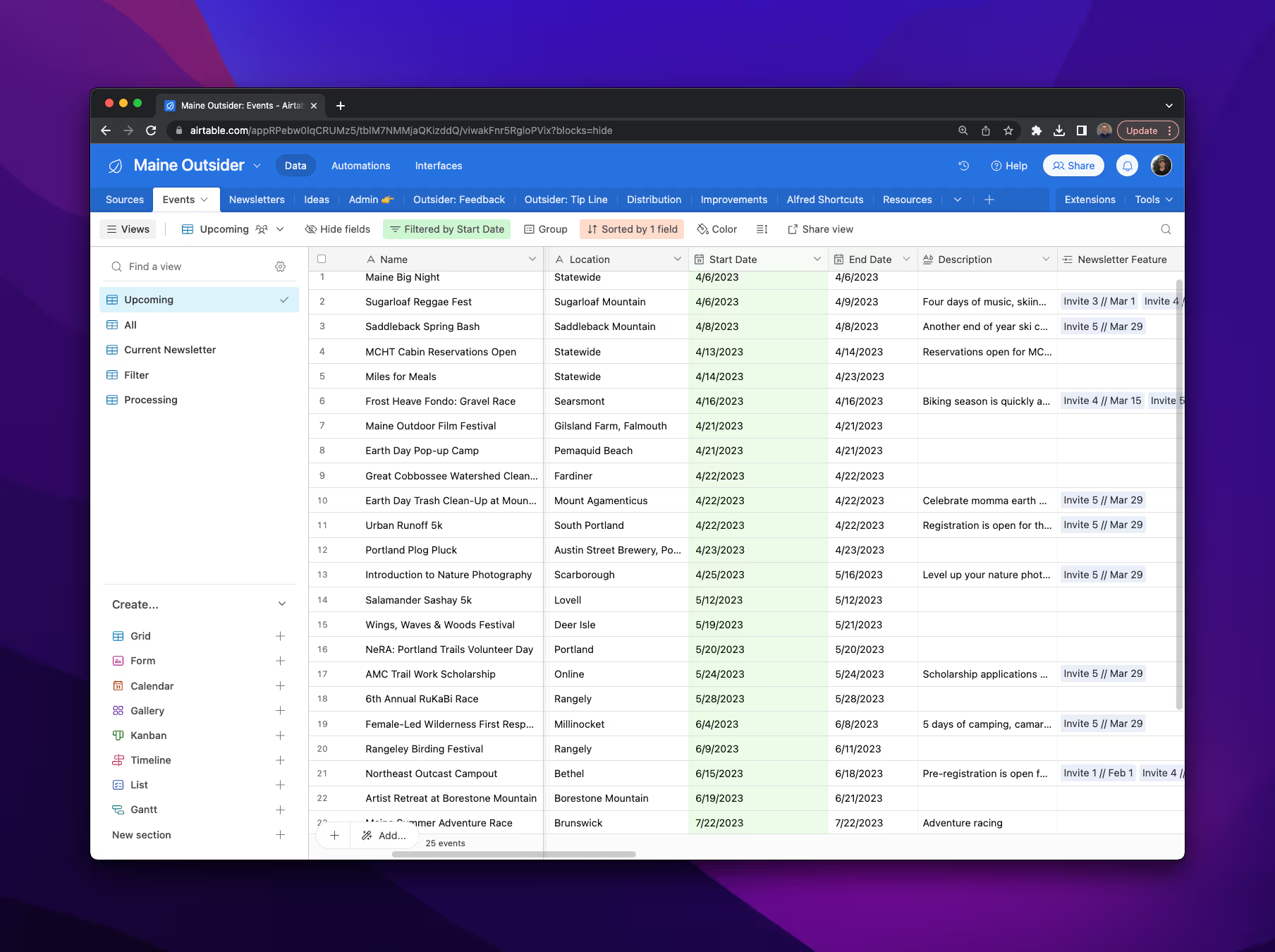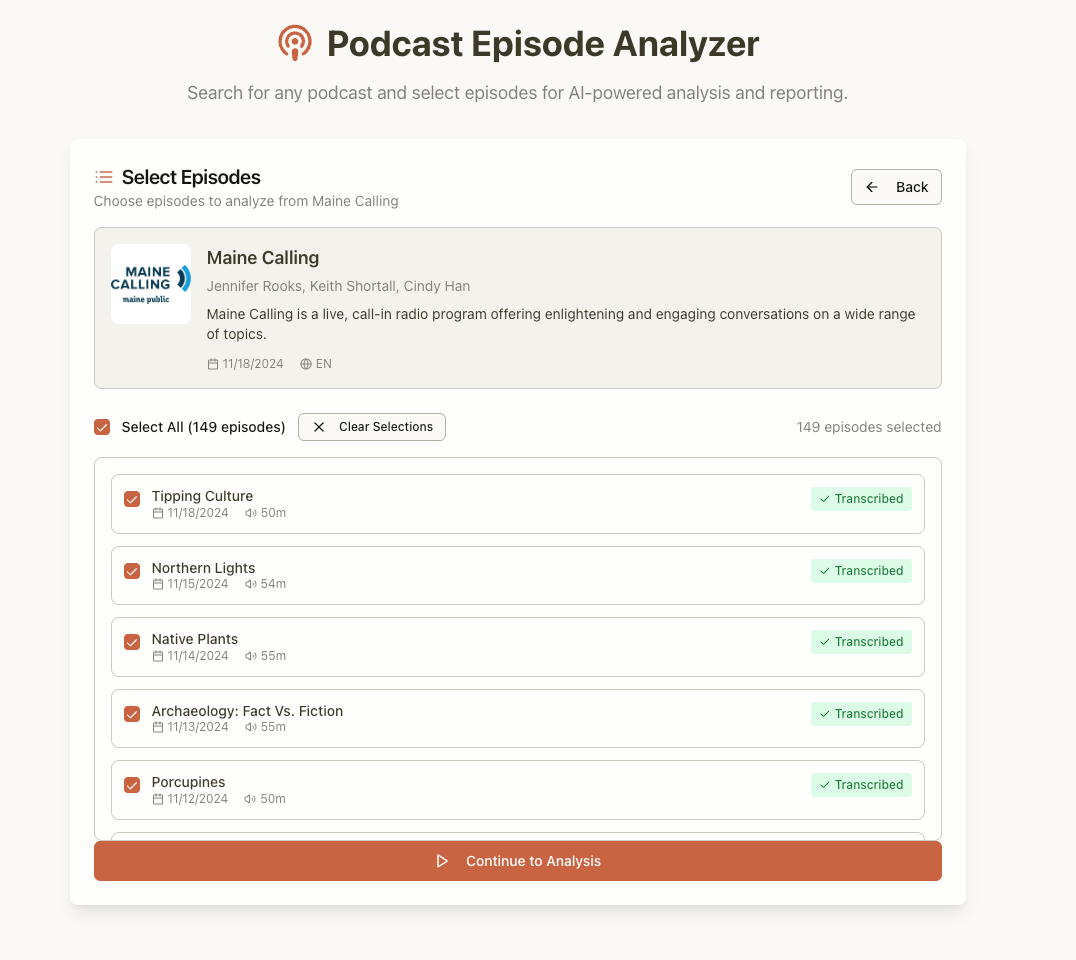How to Run a Curation Newsletter with Ease

I’ve thoroughly enjoyed the process of creating and writing the Maine Outsider, which is an every-other-week roundup of activities in the state. Niche newsletters that connect readers with people, place, and ideas are great. I’d love to support others as they start their own.
In this post, I’ll share a broad framework for thinking through the process with general prompts as well as specific examples from my process. Curation can be overwhelming, but it doesn’t have to be. Choose what feels right for you. Don’t let technical details intimidate you.
Get clear on your why
Unless you’re going to outsource, you’ll be spending a lot of time reading and scanning content to curate the newsletter. Pick something you’re passionate about or want to spend time learning about. Otherwise your passion project might turn into a chore.
For me, that’s outdoor events in Maine. You can read why I started it here.
Create a network of sources
In order to be a curator you need information to curate. I recommend spending a few hours or a day mapping out the different contributors in the space. Set a target before you start, like aiming for 50 sources, so you don’t get trapped in a research hole. You can always add later. A good place to start is to identify nodes in the network. Meaning, look for people, associations, or groups that have influence within your topic. Often, you can start there and branch out. Keep track of your sources in a spreadsheet, document, or data base of some kind.
I use Airtable to keep track of sources and the Airtable web clipper to add them quickly to my base with key info like URL, Description, etc. Early on, I identified two nodes early — Maine Land Trust Network and Maine Outdoor Brands. It was relatively easy to look through their network and start finding sources to add to my own.

In my case, most sources have websites and communicate via newsletters. In other industries they may gather on Instagram or communicate via other platforms.
Figure out your curation workflow
Do not mix your curation feed with your personal feed. I repeat, do not do this. You’ll want a dedicated feed to keep track of your sources and their content. This could be a burner Instagram account, Twitter list, or RSS feed tool. Keeping the curation feed separate allows you to focus your efforts and minimize distractions.
I chose to use Feedly as my primary curation tool. It allows me to subscribe to hundreds of newsletters using dedicated inboxes and read them all in the same place. I don’t have subscriptions crowding out my personal inbox. Feedly works for me because it pulls everything into a single feed, has a highlighting feature, and has a mobile app.

I spend about 2 hrs per week readings and filtering. I review the highlighted content add those events to Airtable via the Web Clipper. When the time comes to write the newsletter, I select what events I want to feature and copy them into my newsletter tool. You could probably create a similar system using a Gmail account with labels or a Twitter list with bookmarks.

Write a test newsletter
It’s probably smart to check whether you have enough content to create a newsletter and test whether you enjoy the experience of creating it before you make public promises. For me, this involved writing and sending the first 3 emails to a group of friends in Gmail before I opened it up to the public. Lowering expectations helped me get started. Taking a few weeks allowed me to refine my process. I found the process joyful and relatively easy. I also learned that I wouldn’t have enough content to support a weekly newsletter, so I was able to adjust my cadence.
Make it public
Whether you have aspirations for a big audience, or prefer a small community doesn’t matter. There is value in sharing. There are many options and tools for publishing a newsletter. Take note of what matters for you and do a little research. Some features to consider: ability to collect payment, marketing and landing page tools, integration, editor experience. If you don’t have a lot of technical experience it might be smart to work with a tool, like Substack that will quickly spin up a landing page with sign up form and host your past newsletters.
.avif)
I chose Convert Kit because they make many of their features available to free users. You only pay when you start to have success. I liked the simplicity of their email editor and onboarding process. Use whatever you want, but if you decide to try Convert Kit, try my affiliate link.
Refine and optimize
If you are design minded or technically adept, you’ll find the process of running a newsletter fun. I’m constantly finding new upgrades and optimizations to make. I was intentionally light on details in this post because I didn’t want to lose people in the weeds. Here are just a few processes I use that help a lot
- Alfred snippet to keep track of my unique Feedly inbox addresses
- Airtable automation that converts dates inputted in web clipper (ie. 4/12/23 - 4/14/23) into Airtable start and end dates (ISO format)
- Airtable script that takes a location as entered in web clipper (ie. Sunday River Ski Area) and geocodes the exact address and lat/long via Google Places API
- Airtable script that maps those locations using Google Maps API and returns a static image to include in the newsletter. This helps geographically challenged readers quickly locate an event.
- Airtable script that loops through all events in a current view and outputs markdown (map image, event description, link), which I can easily copy/paste into Convert Kit

Have fun, but don’t let tech distract from purpose. If you want to talk nitty gritty, hit me up. If you think I should make a course about this, Tweet about it and tag me. I’ll put something together if enough people are interested. Otherwise, happy writing friends.




